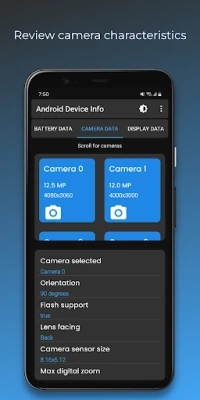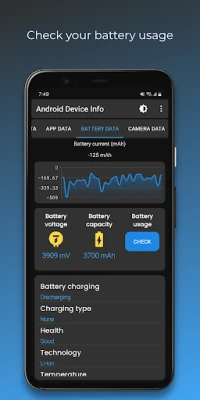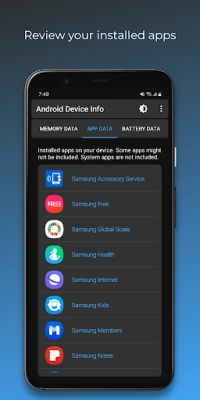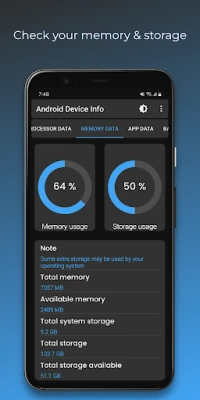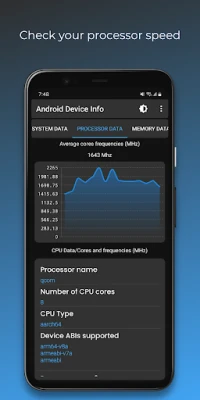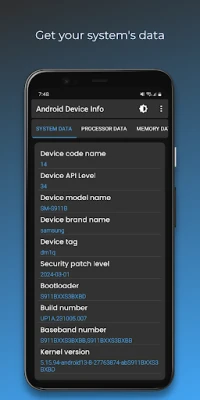
Latest Version
1.9.3
December 29, 2024
Infernus
Tools
Android
0
Free
com.infernus.androiddeviceinfo
Report a Problem
More About Android Device Manager PI
Comprehensive Guide to Android Device Data: Understanding System, Processor, Memory, and More
In the ever-evolving world of Android devices, understanding the various types of data that contribute to a device's performance and functionality is crucial. This guide delves into the essential categories of data, including system, processor, memory, app, battery, camera, display, sensor, and network data. By grasping these concepts, users can make informed decisions about their devices and optimize their usage.
1. System Data: The Backbone of Your Android Device
System data encompasses the core information that defines the operating system and its interactions with hardware. This includes the Android version, build number, and security patches. Keeping your system data updated is vital for security and performance enhancements. Regular updates ensure that your device runs smoothly and is protected against vulnerabilities.
2. Processor Data: The Heart of Performance
The processor, or CPU, is a critical component that determines how efficiently your device operates. Processor data includes specifications such as clock speed, core count, and architecture. Modern Android devices often feature multi-core processors that enhance multitasking capabilities and overall performance. Understanding your processor's capabilities can help you choose apps and tasks that align with your device's strengths.
3. Memory Data: RAM and Storage Explained
Memory data is divided into two main categories: RAM (Random Access Memory) and internal storage. RAM is essential for running applications and multitasking, while internal storage is where your apps, photos, and files are saved. Knowing the amount of RAM and storage available on your device can help you manage your apps effectively and avoid performance slowdowns. Consider upgrading to a device with higher memory specifications if you frequently run resource-intensive applications.
4. App Data: Managing Your Applications
App data refers to the information stored by applications on your device. This includes user preferences, cached files, and downloaded content. Regularly managing app data can free up storage space and improve device performance. Users can clear cache and data for individual apps through the settings menu, ensuring that their devices run efficiently without unnecessary clutter.
5. Battery Data: Understanding Power Consumption
Battery data provides insights into your device's power usage and health. Key metrics include battery capacity, charge cycles, and usage statistics. Monitoring battery data can help you identify apps that drain power excessively and adjust your usage habits accordingly. Utilizing battery-saving modes and optimizing settings can extend your device's battery life, ensuring it lasts throughout the day.
6. Camera Data: Capturing Moments with Clarity
Camera data includes specifications such as megapixel count, aperture size, and sensor type. Understanding these elements can enhance your photography experience. Higher megapixels do not always equate to better quality; factors like lens quality and software processing play significant roles. Familiarizing yourself with your device's camera capabilities can help you take stunning photos and videos.
7. Display Data: The Visual Experience
Display data encompasses screen size, resolution, and technology (such as OLED or LCD). A higher resolution provides sharper images and better color accuracy, enhancing your viewing experience. Understanding display specifications can guide you in selecting devices that meet your visual preferences, whether for gaming, streaming, or general use.
8. Sensor Data: Enhancing Functionality
Sensors play a vital role in the functionality of Android devices. Common sensors include accelerometers, gyroscopes, proximity sensors, and fingerprint scanners. Sensor data allows your device to respond to physical movements and environmental changes, enhancing user interaction. Familiarizing yourself with the sensors available on your device can unlock new features and improve usability.
9. Network Data: Staying Connected
Network data refers to the connectivity options available on your device, including Wi-Fi, Bluetooth, and cellular capabilities. Understanding your network data can help you optimize your connection settings for better performance. For instance, knowing the difference between 4G and 5G can influence your choice of network for faster internet access. Additionally, managing Wi-Fi settings can enhance your browsing experience and conserve battery life.
10. Additional Android Data: Enhancing Your Experience
Beyond the primary categories discussed, there are other minor data points that contribute to the overall functionality of Android devices. This includes software updates, security settings, and user interface customizations. Staying informed about these aspects can significantly enhance your user experience and ensure that your device operates at its best.
Conclusion: Mastering Your Android Device Data
Understanding the various types of data associated with your Android device is essential for optimizing performance and enhancing your overall experience. By familiarizing yourself with system, processor, memory, app, battery, camera, display, sensor, and network data, you can make informed decisions that lead to better device management. Regularly monitoring and managing this data will ensure that your Android device remains efficient, secure, and enjoyable to use.
Rate the App
User Reviews
Popular Apps










Editor's Choice











